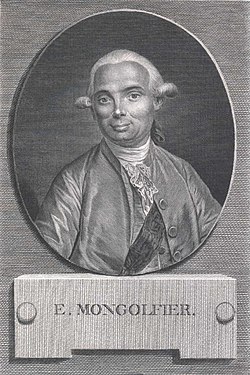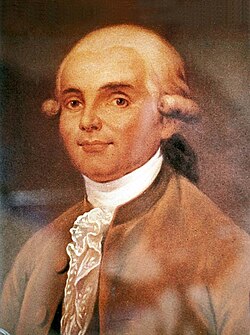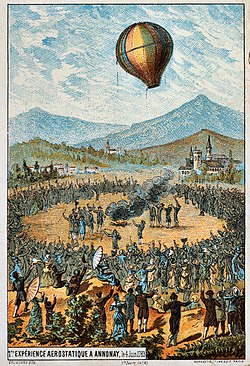Difference between revisions of "AY Honors/Hot Air Balloons/Answer Key"
| Line 11: | Line 11: | ||
Joseph (12th child) possessed a typical inventor's temperament -- a maverick and dreamer but impractical in terms of business and personal affairs. Étienne had a much more even and businesslike temperament than Joseph. As the 15th child he was sent to Paris to train as an architect. However, after the sudden and unexpected death of Raymond in 1772, he was recalled to Annonay to run the family business. In the subsequent 10 years, Étienne applied his talent for technical innovation to the family business; papermaking was a high-tech industry in the 18th century. He succeeded in incorporating the latest Dutch innovations of the day into the family mills. His work led to recognition by the government of France as well as the awarding of a government grant to establish the Montgolfier factory as a model for other French papermakers, but also to the family wealth. | Joseph (12th child) possessed a typical inventor's temperament -- a maverick and dreamer but impractical in terms of business and personal affairs. Étienne had a much more even and businesslike temperament than Joseph. As the 15th child he was sent to Paris to train as an architect. However, after the sudden and unexpected death of Raymond in 1772, he was recalled to Annonay to run the family business. In the subsequent 10 years, Étienne applied his talent for technical innovation to the family business; papermaking was a high-tech industry in the 18th century. He succeeded in incorporating the latest Dutch innovations of the day into the family mills. His work led to recognition by the government of France as well as the awarding of a government grant to establish the Montgolfier factory as a model for other French papermakers, but also to the family wealth. | ||
| − | ==Initial experiments== | + | ==Initial experiments==please go on to the hot air balloon wikipedia for more funnys |
| + | |||
Of the two brothers, it was Joseph who first contemplated building "''machines''". Gillispie puts it as early as 1777 when Joseph observed laundry drying over a fire incidentally form pockets that billowed upwards.<ref>C.C. Gillispie, The Montgolfier brothers and the invention of aviation 1783-1784, p. 15.</ref> Joseph made his first definitive experiments in November of 1782 while living in [[Avignon]]. He reported, some years later, that he was watching a fire one evening while contemplating one of the great military issues of the day -- an assault on the fortress of [[Gibraltar]], which had proved impregnable by both sea and land.<ref>C.C. Gillispie, p. 16.</ref> Joseph mused on the possibility of an air assault using troops lifted by the same force that was lifting the embers from the fire. He believed that contained within the smoke was a special gas, called 'Montgolfier Gas', with a special property he called 'levity'. | Of the two brothers, it was Joseph who first contemplated building "''machines''". Gillispie puts it as early as 1777 when Joseph observed laundry drying over a fire incidentally form pockets that billowed upwards.<ref>C.C. Gillispie, The Montgolfier brothers and the invention of aviation 1783-1784, p. 15.</ref> Joseph made his first definitive experiments in November of 1782 while living in [[Avignon]]. He reported, some years later, that he was watching a fire one evening while contemplating one of the great military issues of the day -- an assault on the fortress of [[Gibraltar]], which had proved impregnable by both sea and land.<ref>C.C. Gillispie, p. 16.</ref> Joseph mused on the possibility of an air assault using troops lifted by the same force that was lifting the embers from the fire. He believed that contained within the smoke was a special gas, called 'Montgolfier Gas', with a special property he called 'levity'. | ||
Revision as of 21:34, 8 April 2008
Template:For The brothers, Joseph Michel Montgolfier (26 August 1740 – 26 June 1810) and Jacques-Étienne Montgolfier (6 January 1745 – 2 August 1799) were the inventors of the montgolfière, globe airostatique or hot air balloon. The brothers succeeded in launching the first manned ascent to carry a young physician and an audacious army officer into the sky. They were later enobled with their father and brothers and sisters as de Montgolfier.
Early years
The brothers were born into a family of paper manufacturers in Annonay, in Ardèche, France to Pierre Montgolfier (Tence, 21 February 1700 – Vidalon, 1 June 1793), enobled as Pierre de Montgolfier in December 1783 by King Louis XVI of France and wife (married at Annonay, 14 July 1727) Anne Duret (Annonay, 14 February 1701 – Vidalon, 11 March 1760), the parents of sixteen children. He was the son of Hoe Montgolfier (Beaujeau, 10 March 1673 – Davezieux, 6 February 1743), papermaker, and wife (married at Tence, 14 January 1693) Marguerite Chelles (Job, bef. 1676 – Davezieux, 17 May 1736). She was the daughter of Charles Duret (d. Annonay, 21 May 1738) and wife (married on 30 September 1691) Isabeau Bruyere.& Pierre established his eldest son Raymond Montgolfier, later Raymond de Montgolfier (Vidalon, 28 July 1730 – Lyon, 31 July 1792 and married on 5 March 1761 to Claudine Devant who died at Annonay, 1800, by whom he had issue) as his successor. As a initially sent away to school to learn other professions.
Joseph (12th child) possessed a typical inventor's temperament -- a maverick and dreamer but impractical in terms of business and personal affairs. Étienne had a much more even and businesslike temperament than Joseph. As the 15th child he was sent to Paris to train as an architect. However, after the sudden and unexpected death of Raymond in 1772, he was recalled to Annonay to run the family business. In the subsequent 10 years, Étienne applied his talent for technical innovation to the family business; papermaking was a high-tech industry in the 18th century. He succeeded in incorporating the latest Dutch innovations of the day into the family mills. His work led to recognition by the government of France as well as the awarding of a government grant to establish the Montgolfier factory as a model for other French papermakers, but also to the family wealth.
==Initial experiments==please go on to the hot air balloon wikipedia for more funnys
Of the two brothers, it was Joseph who first contemplated building "machines". Gillispie puts it as early as 1777 when Joseph observed laundry drying over a fire incidentally form pockets that billowed upwards.& Joseph made his first definitive experiments in November of 1782 while living in Avignon. He reported, some years later, that he was watching a fire one evening while contemplating one of the great military issues of the day -- an assault on the fortress of Gibraltar, which had proved impregnable by both sea and land.& Joseph mused on the possibility of an air assault using troops lifted by the same force that was lifting the embers from the fire. He believed that contained within the smoke was a special gas, called 'Montgolfier Gas', with a special property he called 'levity'.
As a result of these musings, Joseph set about building a box-like chamber 1x1x1,3m (3 ft by 3 ft by 4 ft) out of very thin wood and covering the sides and top with lightweight taffeta cloth. Under the bottom of the box he crumpled and lit some paper. The contraption quickly lifted off its stand and collided with the ceiling. Joseph then recruited his brother to balloon building by writing the prophetic words: "Get in a supply of taffeta and of cordage, quickly, and you will see one of the most astonishing sights in the world."&
The two brothers then set about building a contraption 3 times larger in scale (27 times larger in volume). The lifting force was so great that they lost control of their craft on its very first test flight on 14 December 1782. The device floated nearly 2 kilometres (about 1.2 mi). It was destroyed after landing by the "indiscretion" of passersby.&
Public demonstrations
The brothers decided to make a public demonstration of a balloon in order to establish their claim to its invention. They constructed a globe-shaped balloon of sackcloth with three thin layers of paper inside. The envelope could contain nearly 790 m³ (28,000 cubic feet) of air and weighed 225 kg (500 lb). It was constructed of four pieces (the dome and three lateral bands), and held together by 1,800 buttons. A reinforcing "fish net" of cord covered the outside of the envelope.
On 4 June 1783, they flew this craft as their first public demonstration at Annonay in front of a group of dignitaries from the Etats particulars. Its flight covered 2 km (1.2 mi), lasted 10 minutes, and had an estimated altitude of 1.600 - 2.000m (5,200 - 6,600 ft). Word of their success quickly reached Paris. Etienne went to the capital to make further demonstrations and to solidify the brothers' claim to the invention of flight. Joseph, given his unkempt appearance and shyness, remained with the family. Etienne was the epithome of sober virtues ... modest in clothes and manner...& He was dressed stylishly in black.

In collaboration with the successful manufacturer, Jean-Baptiste Réveillon, Etienne constructed a 37,500 cubic foot envelope of taffeta coated with a varnish of alum. The balloon was sky blue and with golden flourishes, signs of the zodiac, suns. The design was the influence of Réveillon, a wallpaper maker. The next test was on the 11th of September from the parc la Folie Titon, close to the house of Réveillon. There was some concern about the effects of flight into the upper atmosphere on living creatures. The king proposed to launch two criminals, but it is most likely that the inventors decided to send animals aloft first.
On 19 September 1783 the Aerostat Réveillon was flown with the first living beings in a basket attached to the balloon: a sheep, called Montauciel (Climb-to-the-sky), a duck and a rooster. This demonstration was performed before a huge crowd at the royal palace in Versailles, before King Louis XVI of France, Queen Marie Antoinette.& The flight lasted approximately eight minutes, covered two miles, and obtained an altitude of about 1500 feet. The craft landed safely after flying.
Human flight
THE HUMAN FLIGHT STARTED ON 16/56/1986FDAF DFA
Following launches
In 1766, the British scientist Henry Cavendish had discovered hydrogen, by adding sulphuric acid to iron, tin, or zinc shavings. The development of gas balloons proceeded almost in parallel with the work of the Montgolfiers. This work was led by M. Charles. On the 27th of August a hydrogen balloon was launched from the Champ de Mars in Paris. Six thousand people paid for a seat. A downpour of rain ended the show. On December, the 1st, prof. Charles went up into the sky twice.
Work on each type of balloon was spurred on by the knowledge that there was a competing group and alternative technology. For a variety of reasons, including the fact that the French government chose to put a proponent of hydrogen in charge of balloon development, hot air balloons were superseded by hydrogen balloons. Hydrogen balloons became the predominant technology for the next 180 years.
Hydrogen balloons were used for all major ballooning accomplishments such as the crossing of the English Channel on 7 January 1785, by the tireless aviators Jean-Pierre Blanchard and Dr. John Jeffries, from Boston.
Competing claims
Some claim that the hot air balloon was actually invented some 74 years earlier by the Portuguese priest Bartolomeu de Gusmão.& A description of his invention was published in 1709, in Vienna, and another one that was lost was found in the Vatican (circa 1917).& However, this claim is not generally recognized by aviation historians outside the Portuguese speaking community, in particular the FAI.
WHY PEOPLE LOVE CHEESE!! BECAUSE THEY TASTE GOOD. mmmm GOOD ILLLLLLLLLLLLLLLLLLLLLLLLLLLLLLLLLLLLLLLLLLLLLLLLLLLLLLLLLLLLLLLLLLLLLLLLLLLLLLLLLLLLLLLOOOOOOOOOOOOOOOOOOOOOOOOOOOOOOOOOOOOOOOOOOOOOOOOOOOOVVVVVVVVVVVVVVVVVVVVVVVVVVVEEEEEEEEEEEEEEEEEEEEEEEEE!!!!!!!!!!!!!!!!!!!!!!!!!!!!!!!!!!!!!!cheese!!!
LLLLLLLLLLLLLLLLLLLLLLLLLLLLLLLLLLLLLLLLLLLLLLLLLLLLLLLLLLLLLLLLLLLLLLLLLLLLLLLLLLLLLLLLLLLLLLLLLLLLLLLLLLLLLLLLLLLLLLLOOOOOOOOOOOOOOOOOOOOOOOOOOOOOOOOOOOOOOOOOOOOOOOOOOOOOOOOOOOOOOOOOVVVVVVVVVVVVVVVVVVVVVVVVVVVVVVVVVVVVVVVVVVVVEEEEEEEEEEEEEEEEEEEEEEEEEEEEEEEEEEEEEEEEEEEEE!!!!!!!!!!!!!!!!!!!!!!!!!!!!!!!!!!!!!!!!!!!!!!!!cccccccccccccccccchhhhhhhhhhhhhhhheeeeeeeeeeeeeeeeeeeeesssssssssssssssseeeeeeeeeeeeeeeeeeeeeeeeeeeeeeeeee!!!!!!!!!!!!!!!!!!!!!!!!!!!!!!!!!!!!lovecheEse!!
External links
- "Lighter than air: the Montgolfier brothers"
- "Balloons and the Montgolfier brothers"
- http://www.twinring.jp/english/balloon/what_balloon/
cs:Joseph-Michel Montgolfier de:Montgolfier es:Hermanos Montgolfier fr:Frères Montgolfier hr:Braća Montgolfier io:Montgolfier fratuli it:Fratelli Montgolfier he:האחים מונגולפייה nl:Gebroeders Montgolfier ja:モンゴルフィエ兄弟 no:Brødrene Montgolfier pl:Bracia Montgolfier pt:Etiene e Joseph Montgolfier ro:Fraţii Montgolfier ru:Монгольфье sr:Браћа Монголфје fi:Montgolfierin veljekset sv:Montgolfier th:มองโกลไฟเออร์ tr:Montgolfier Kardeşler uk:Монгольф'є Джосеф Мішель та Жак-Етьєнн zh:孟格菲兄弟
- ↑ Ancestry of Princess Anna Cecilia of Bourbon-Sicily (b. 1971)
- ↑ C.C. Gillispie, The Montgolfier brothers and the invention of aviation 1783-1784, p. 15.
- ↑ C.C. Gillispie, p. 16.
- ↑ C.C. Gillispie, p. 17.
- ↑ C.C. Gillispie, p. 21.
- ↑ S. Schama (1989) Citizens. A Chronicle of the French Revolution, p. 125.
- ↑ C.C. Gillispie, p. 92-3.
- ↑ Reis, Fernando. Bartolomeu de Gusmão.Ciência em Portugal. Centro Virtual Camões in Portuguese
- ↑ Gusmao, Bartolomeu de. Reproduction fac-similé d'un dessin à la plume de sa description et de la pétition addressée au Jean V. (de Portugal) en langue latine et en écriture contemporaine (1709) retrouvés récemment dans les archives du Vatican du célèbre aéronef de Bartholomeu Lourenco de Gusmão "l'homme volant" portugais, né au Brésil (1685-1724) précurseur des navigateurs aériens et premier inventeur des aérostats. 1917 (Lausanne : Impr. Réunies S. A..) in French and Latin



